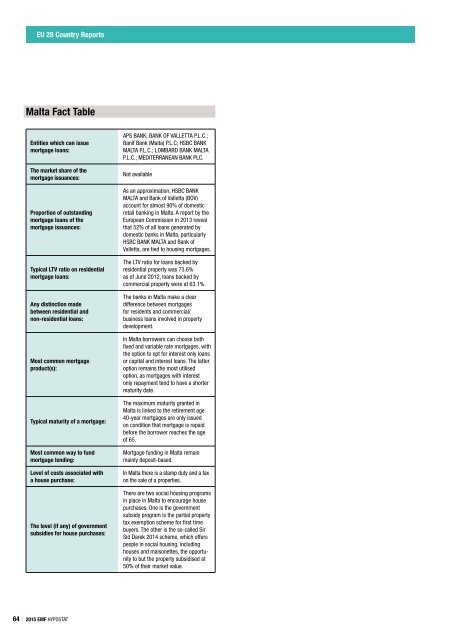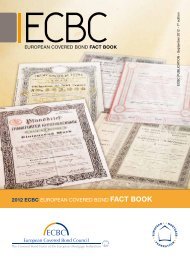Hypostat 2015
On 30 September 2015, the EMF-ECBC published Hypostat 2015 , which is its main statistical report, encompassing data on recent developments in housing and mortgage markets in the EU28 and beyond. Hypostat is the result of a collaborative effort by the European Mortgage Federation’s national delegations and external experts. The publication covers 33 countries – i.e. the EU28 plus Iceland, Norway, Russia, Turkey and the United States.
On 30 September 2015, the EMF-ECBC published Hypostat 2015 , which is its main statistical report, encompassing data on recent developments in housing and mortgage markets in the EU28 and beyond. Hypostat is the result of a collaborative effort by the European Mortgage Federation’s national delegations and external experts.
The publication covers 33 countries – i.e. the EU28 plus Iceland, Norway, Russia, Turkey and the United States.
Create successful ePaper yourself
Turn your PDF publications into a flip-book with our unique Google optimized e-Paper software.
EU 28 Country Reports<br />
Malta Fact Table<br />
Entities which can issue<br />
mortgage loans:<br />
The market share of the<br />
mortgage issuances:<br />
Proportion of outstanding<br />
mortgage loans of the<br />
mortgage issuances:<br />
Typical LTV ratio on residential<br />
mortgage loans:<br />
Any distinction made<br />
between residential and<br />
non‐residential loans:<br />
Most common mortgage<br />
product(s):<br />
Typical maturity of a mortgage:<br />
Most common way to fund<br />
mortgage lending:<br />
Level of costs associated with<br />
a house purchase:<br />
The level (if any) of government<br />
subsidies for house purchases:<br />
APS BANK; BANK OF VALLETTA P.L.C.;<br />
Banif Bank (Malta) P.L.C; HSBC BANK<br />
MALTA P.L.C.; LOMBARD BANK MALTA<br />
P.L.C.; MEDITERRANEAN BANK PLC.<br />
Not available<br />
As an approximation, HSBC BANK<br />
MALTA and Bank of Valletta (BOV)<br />
account for almost 90% of domestic<br />
retail banking in Malta. A report by the<br />
European Commission in 2013 reveal<br />
that 52% of all loans generated by<br />
domestic banks in Malta, particularly<br />
HSBC BANK MALTA and Bank of<br />
Valletta, are tied to housing mortgages.<br />
The LTV ratio for loans backed by<br />
residential property was 73.6%<br />
as of June 2012, loans backed by<br />
commercial property were at 63.1%.<br />
The banks in Malta make a clear<br />
difference between mortgages<br />
for residents and commercial/<br />
business loans involved in property<br />
development.<br />
In Malta borrowers can choose both<br />
fixed and variable rate mortgages, with<br />
the option to opt for interest only loans<br />
or capital and interest loans. The latter<br />
option remains the most utilised<br />
option, as mortgages with interest<br />
only repayment tend to have a shorter<br />
maturity date.<br />
The maximum maturity granted in<br />
Malta is linked to the retirement age.<br />
40-year mortgages are only issued<br />
on condition that mortgage is repaid<br />
before the borrower reaches the age<br />
of 65.<br />
Mortgage funding in Malta remain<br />
mainly deposit-based.<br />
In Malta there is a stamp duty and a tax<br />
on the sale of a properties.<br />
There are two social housing programs<br />
in place in Malta to encourage house<br />
purchases. One is the government<br />
subsidy program is the partial property<br />
tax exemption scheme for first time<br />
buyers. The other is the so-called Sir<br />
Sid Darek 2014 scheme, which offers<br />
people in social housing, including<br />
houses and maisonettes, the opportunity<br />
to but the property subsidised at<br />
50% of their market value.<br />
64 | <strong>2015</strong> EMF HYPOSTAT



